This species has been observed on Reunion, Mauritius and Madagascar Islands
Species characteristics : Variable in colour and easely recognized by the shear zones on the mantle. The body is divided dorsally into four (fused) parts, three of which readily autotomize. The main central section is surrounded by three crescent-shaped lobes, two lateral ones which meet anteriorly at the midline, and a posterior one. The extremity of the two cylindrical rhinophores and the two oral tentacles attached to either side of an oral veil visible on the head are black |

|
|
| Showing species characteristics... | Photo Sully Bachel |
|
See more about : Sightening and mating periods
See more about : Berthella martensi, spawning behavior
See more about : Berthella martensi variability in Southwest Indian ocean
Remarks :
Identification confirmed by Bill Rudman , Nathalie Yonow and Hsini Lin
We can observed three color form in our area : A yellow-brown reticulated form, a yellow-brown dotted form and a white form.
Synonymous : (according Worms)
- Berthella kaniae Sphon, 1972
- Gymnotoplax martensi pilsbry, 1896
- Pleurobranchus scutatus Martens, 1880
Bibliographic data :
This species is extremely variable in color and ranges from white, yellow, brown or black, with or without mottlings of a different color.
The trapezoidal oral veil and rhinophores are visible from above but the tail is usually covered by the mantle. The rhinophores are fused at their bases
There is a brown line edging the foot and one extending from the oral veil edges posteriorly between the mantle and the foot.
The gill is located on the right side, orange with dark brown to black rachides on the pinnae.
It is characterised by its ability to autotomise (break off) large sections of its mantle when disturbed. The brown central ring and the lines visible in paler animals marks the breakage point when the animals breaks off its mantle skirt.
The metapodium bears a brown patch on the end in the larger specimen and a median line on the smaller animal.
The mantle can produce a white fluid when the animal is disturbed.
The animals found in shallow water were associated, for the most part, with a mixed live/dead stony coral reef environment; those animals collected from deeper waters usually on vertical, invertebrate-covered walls at the reef drop off.
According to bill Rudman, this species feeds on sponges (as other species of Berthella). And according to Gosliner this species feeds upon tunicates.
According to Willan (1984) it lays a flaccid white spawn coil. Ova measuring 75-95 µm occur singly in capsules (up to 190 µm diameter) that are loosely coiled in cylinders within the spawn. Approximately 315 ova make up a single spawn.
Thin, convex, "papyracée" and yellowish shell. The internal face is cover by a thin calcareous layer.
In Reunion Island , we have actually found three color forms :
- A yellow-brown form (upper photo), the preponderant form in our island. Marina Poddubetskaia observed the same color form in Mauritius.
- A white form (see below, Emmanuel Eby's specimen), sometimes spcekled with black to dark brown spots.
- A small yellow-brown dotted form, ( see below Hugues Flodrops' specimen and "spawning behavior")
Recorded from Mauritius by Martens (1880) and Bergh (1898) as Pleurobranchus scutatus and by Yonow and Hayward (1991) as B. martensi
If you found an other color form in Reunion Island, please Contact us...
References :
Bill Rudman Seaslug site : Sea Slug Forum : Berthella martensi
Nudipixel Berthella martensi
Publications :
Ortea J., Moro L. & Caballer M. (2014). Contribución al estudio de la familia Pleurobranchidae Gray, 1827 (Mollusca: Opisthobranchia) en la Macaronesia y las islas Galápagos. Vieraea. 42: 117-148.
Tsubokawa, R. & Bolland, R.F. (1991). Berthella martensi (Pilsbry, 1896), new to the Japanese Notaspidea Fauna. Venus, Japanese Journal of Malacology, 50(3) : 184-195
Willan, R.C. (1984) The Pleurobranchidae (Opisthobranchia: Notaspidea) of the Marshall Islands, Central-West Pacific Ocean. The Veliger, 27(1) : 37-53.
Yonow, N. (1994) Opisthobranchs from the Maldive Islands, including descriptions of seven new species (Mollusca: Gastropoda). Revue fr. Aquariol., 20(4) : 97-130.
Other photos of Berthella martensi :
It is characterised by its ability to autotomise (break off) large sections of its mantle when disturbed.this specimen has lost the right section of the mantle... The gill (a) is located on the right side, orange with dark brown to black rachides on the pinnae. The reproductive aperture (b) |
Kévin Bourdon Reunion, Cap La Houssaye, 14m, 22 June 2013 |
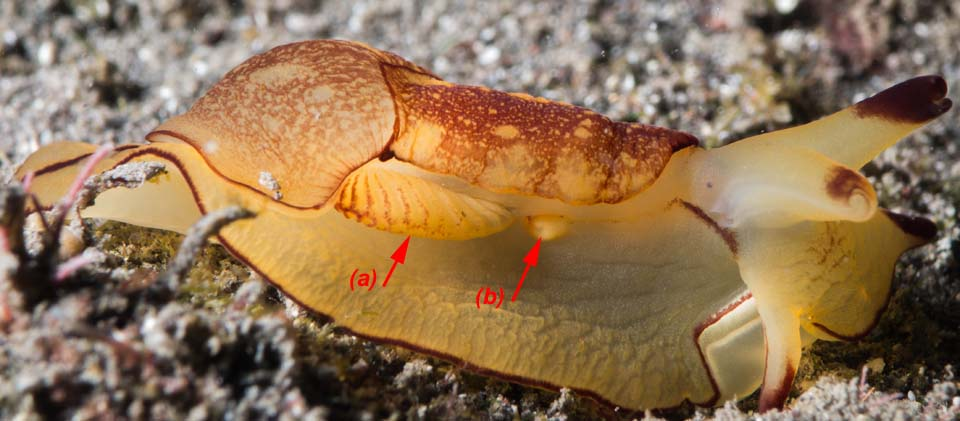 |
|
Maurice Jay Reunion, 10-12 m Thin, convex, "papyracée" and yellowish shell. The internal face is cover by a thin calcareous layer.
|
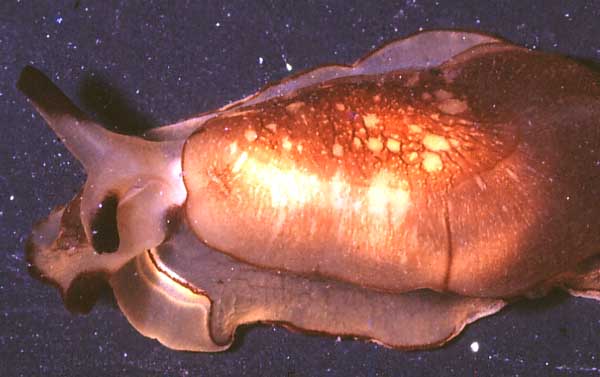 |
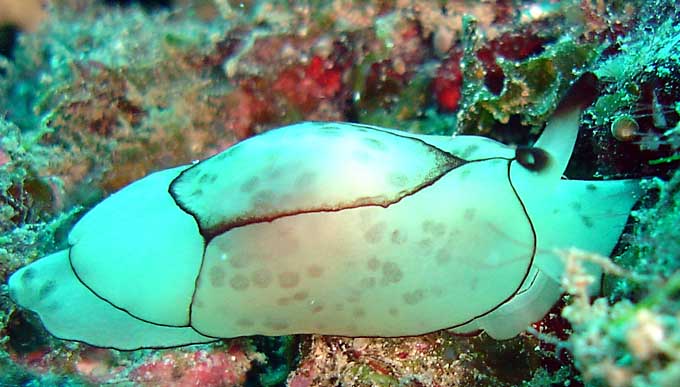 |
Emmanuel Eby Reunion, "Les antennes" at Saint leu, 12m, size : 20-25 mm, 04 May 2005. A white form. We clearly see in this photo the internal face of the cylindrical rhinophore.
|
Hugues Flodrops Reunion, Etang salé on a rocky coast, 30 cm, 6 January 2007, size 25 mm A small yellow-brown dotted form
|
 |
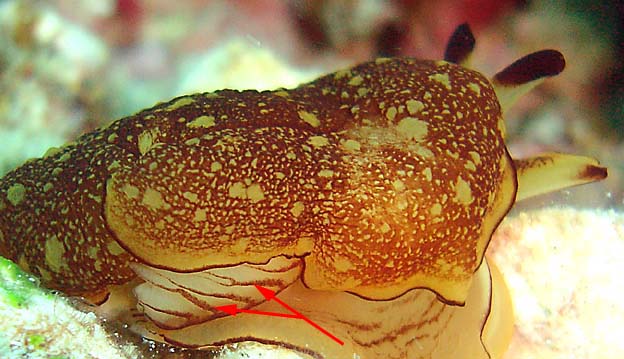 |
Emmanuel Eby Reunion, Saint Leu, 15 October 2005 A yellow-brown reticulated form. In this specimen you can observe the large plume-like gill located between the well developed foot and overlapping mantle, on the right side of the body The gill is orange with dark brown to black rachides on the pinnae.
|
Emmanuel Eby Reunion, Saint Leu, 02 September 2005 The metapodium bears a brown patch on the end in the larger specimen and a median line on the smaller animal. The body is divided dorsally into four (fused) parts, three of which readily autotomize. The main central section is surrounded by three crescent-shaped lobes, two lateral ones which meet anteriorly at the midline, and a posterior one. | 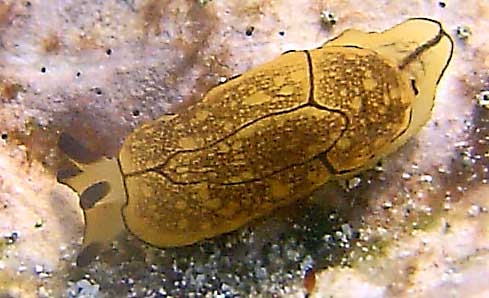 |
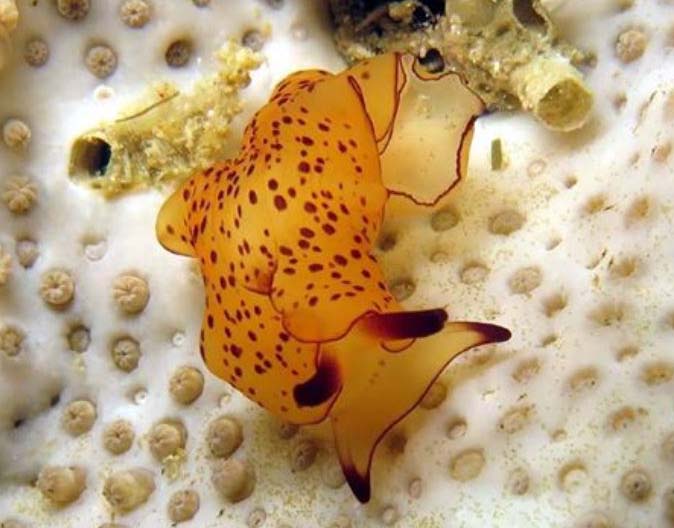 |
Nathalie Bazard Madagascar, Nosy Bé, Plateau des arches, 15 m, size : 30- 40 mm
|
More photos from Indian Ocean
See more about : Berthella martensi spawing behavior
See more about : Berthella martensi variability in Southwest Indian ocean
Mauritius, Berthella martensi, at Pereybere, by Marina Poddubetskaia
Reunion, a decolorated white form of Berthella martensi, at Saint Leu, by Sebastien Pomarede
Mauritius, Berthella martensi, at Grand Baie, by Mathieu Bayon
Reunion, hide and seek with Berthella martensi, at Saint Leu, by Emmanuel Eby
Reunion, Berthella martensi, in Saint Leu lagoon, by Guillaume Boeye
Reunion, a white and dark brown form of Berthella martensi, at Saint Leu, by Philippe Cao Van
Reunion, a dark brown speckled Berthella martensi, by Philippe Cao Van
Reunion, two form of Berthella martensi, at Etang salé, by Hugues Flodrops
Reunion, gills of white form of Berthella martensi, at Saint Leu, by Sully Bachel
Rodrigues, a yellow-brown dotted form of Berthella martensi, at Mourouck, by Raphaël Roland Gosselin
Reunion, white form with numerous grey spots B. martensi, at Saint Gilles, by Raphaël Roland Gosselin
Reunion, partially eaten Berthella martensi, at Trou d'eau, by Philibert Bidgrain
Reunion, when a large seaslug crawl on a small one, at Etang salé, by Jean-Marie Gradot
